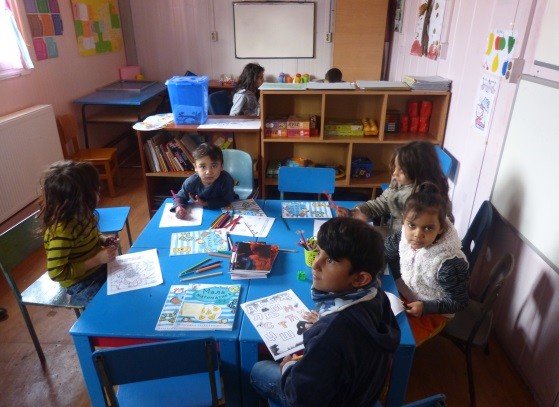
February 2016—In the 1990s, the Kosovo education system was in chaos, especially for ethnic minority students. For education in their native language, Albanian-speaking students could only attend informal, privately run classes. Minority Roma, Ashkali and Egyptian children largely didn’t go to school at all.
Following the war in 1999, however, there has been a steadily increasing emphasis on improving the quality of education for everyone.
When he was 12, Ardian Shabani, a member of the Ashkali community, joined a special class at the learning center in Shtime/Štimlje for extra homework help. He enjoyed it so much that, two summers ago, he volunteered to help with the annual summer camp, then again the next year. Even now that he has graduated from high school, he’s back at the learning center every day of the week, helping other students as a tutor.
“A few years ago, I was in the same seats, being tutored myself!” he says. Next year, he adds, “I would like to study in the university to become an educator.”
In 2009, the learning center in Shtime/Štimlje started to offer extra homework help to students from the minority Ashkali and Egyptian communities. It has expanded activities ever since, and now it includes three classrooms, a library and a five-week summer program.
The learning center is one of five in Kosovo that USAID supported from February 2014 through December 2015 to improve inclusive education. The centers are administered by Balkan Sunflowers Kosova in cooperation with People in Need.
“We’re lucky that now we can integrate more minorities in all that we do,” says Skender Bajrami, the director of Emin Duraku primary school, which hosts the Shtime/Štimlje learning center. “In the beginning, we were pessimistic that this would distract other children—but now we think that this is a stronger experience for all.”
It doesn’t serve only minority students. Although Albanians are an ethnic majority in the municipality, many of them are also interested in the activities offered to help learn math, language arts and science.
The learning center in Fushë Kosovë/Kosovo Polje operates an even bigger program than the one in Shtime/Štimlje, including many Roma students as well as Ashkali and Egyptians. Because it confronts additional barriers, it provides additional services.
For example, many children speak the Roma language at home, and some are going into Serbian-language schools. The center provides multiple classes of homework help in shifts to accommodate students’ schedules and great interest in the program. Three times a week, the center also offers a class for adult women to improve their basic literacy and learn new handicrafts.
As recently as 2008, 50 percent of students were dropping out of high school in Fushë Kosovë/Kosovo Polje, so the learning center arranged for mediators to work with young people to encourage them to return to school or never drop out in the first place. Now, the number dropping out each year are “few enough to count on your fingers,” according to Rrahmon Stollaku, the coordinator of the center.
The center also operates the only preschool free of charge in the municipality, introducing young children to letters and numbers in Albanian or Serbian so they will be better prepared to enter the school system at age 6.
“We study two letters a week—we tie them to a name so that students can remember them,” says Artan Asllani, a preschool teacher. “We make an A with a rope on the floor, and the children can walk on it. Then we place it on a big paper so they can see it …. As we see the children have good motor control in their hands, we start to have them write on the big papers, in the notebooks …. They take the books, and they try to read with the pictures. They say, this is an A!”
That simply, young students begin a successful education. What careers will they choose when their education is complete?
Time will tell.
LINKS
Follow @USAIDKosovo. on Facebook, on YouTube







Comment
Make a general inquiry or suggest an improvement.